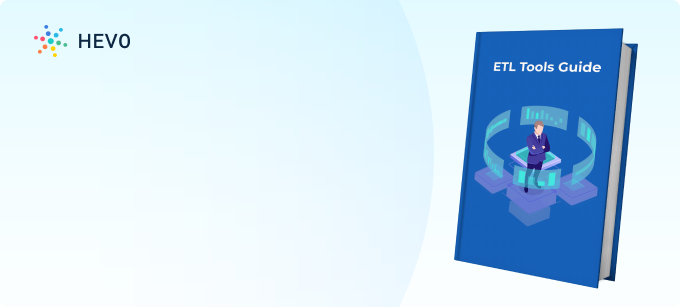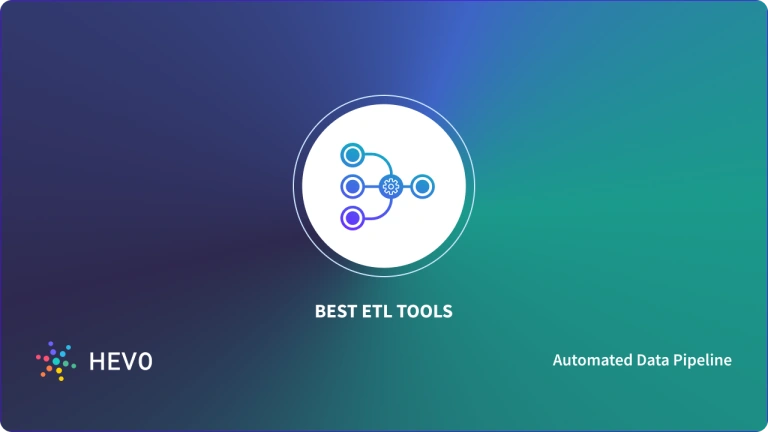Are you confused, which is the best DynamoDB ETL tool available? If yes, then you must go through this detailed blog before you start your DynamoDB ETL process.
This blog will introduce you to ETL, discuss some of the popular tools, also their efficacy and applicability. By the end of this blog, you will be able to choose the right DynamoDB ETL tool for yourself.
Table of Contents
What is DynamoDB?etl tools
DynamoDB is a NoSQL database that supports key-value and documents data structures. It’s a fully managed AWS solution that provides fast and predictable performance with seamless scalability. DynamoDB offers high performance with a data replication option.
It allows companies to deploy their real-time applications in more than one geographical location. It also offers encryption at rest, using which you can build secure applications that meet strict encryption compliance and regulatory requirements.
Many of the world’s fastest-growing businesses, such as Major League Baseball (MLB), Lyft, Airbnb, and Redfin as well as enterprises such as NTT Docomo, Toyota, and GE Healthcare depend on the scale and performance of DynamoDB to support their mission-critical workloads.
Introduction to DynamoDB ETL Tools
Why Do You Need the Right Tools?
ETL tools form the backbone of your data workflows, and when correctly aligned to meet your needs, they make it quite easy to handle and transform large volumes of data with less effort.
The right tools can handle the complexities of data integration, ensuring that your ETL workflows are efficient, scalable, and capable of meeting the demands of your growing business. We will discuss how the right ETL tools will help you save time, reduce errors, and optimize your data processing so you’re not just keeping up with the data but actively using it for better decisions.
Overview of ETL Process in DynamoDB
The ETL (Extract, Transform, Load) process in DynamoDB involves a series of steps to move and prepare data for use in your applications. Here’s a quick overview:
- Extract: This step involves retrieving data from various sources, such as databases, APIs, or files. With DynamoDB, this might include pulling data from other AWS services or external systems.
- Transform: Once the data is extracted, it needs to be transformed to match DynamoDB’s schema and ETL requirements. This could involve filtering, aggregating, or converting data formats to ensure compatibility with DynamoDB’s NoSQL structure.
- Load: Finally, the transformed data is loaded into DynamoDB. Depending on your use case, this step might include batch processing or real-time streaming of data. The goal is to ensure the data is readily available for querying and use within your DynamoDB tables.
Criteria for Choosing DynamoDB ETL Tools
- Scalability and Performance: Ensure the tool can handle large and growing datasets efficiently without compromising speed.
- Integration Capabilities: Look for tools that integrate seamlessly with AWS services and other platforms you use.
- Cost-Effectiveness: Balance the tool’s features with its pricing to ensure it fits your budget while meeting your needs.
- Ease of Use: Choose tools that are user-friendly and straightforward to implement, reducing the learning curve for your team.
With Hevo, simply connect your DynamoDB database to your preferred data warehouse and watch your data load in a matter of minutes. Enjoy a stress-free, low-maintenance data load.
2000+ customers trust Hevo for the following reasons:
- Hevo’s real-time streaming architecture helps you get faster insights.
- It identifies schema changes in your incoming data and automatically replicates those in your destinations.
- Hevo’s fault-tolerant architecture assures that no data is lost even if a pipeline fails.
Try Hevo today to experience seamless data transformation and migration.
Get Started with Hevo for FreeList Of Best DynamoDB ETL Tools
Choosing the perfect DynamoDB ETL tool that perfectly fits your business needs can be a daunting task, especially when a large number of tools are available on the market. To make your search easier, here is a complete list of the 9 best DynamoDB ETL tools for you to choose from and easily start setting up your ETL pipeline.
1) Hevo Data
Hevo Data, a No-code Data Pipeline reliably replicates data from any data source with zero maintenance. You can get started with Hevo’s 14-day Free Trial and instantly move data from 150+ pre-built integrations comprising a wide range of SaaS apps and databases. What’s more – our 24X7 customer support will help you unblock any pipeline issues in real-time.
With Hevo, fuel your analytics by not just loading data into Warehouse but also enriching it with in-built no-code transformations. Its fault-tolerant ETL architecture ensures that the data is handled in a secure, consistent manner with zero data loss.
Check out what makes Hevo amazing:
- Near Real-Time Replication: Get access to near real-time replication on All Plans. Near Real-time via pipeline prioritization for Database Sources. For SaaS Sources, near real-time replication depend on API call limits.
- In-built Transformations: Format your data on the fly with Hevo’s preload transformations using either the drag-and-drop interface or our nifty python interface. Generate analysis-ready data in your warehouse using Hevo’s Postload Transformation.
- Monitoring and Observability: Monitor pipeline health with intuitive dashboards that reveal every stat of pipeline and data flow. Bring real-time visibility into your ETL with Alerts and Activity Logs.
- Reliability at Scale: With Hevo, you get a world-class fault-tolerant architecture that scales with zero data loss and low latency.
Hevo provides Transparent Pricing to bring complete visibility to your ETL spend.
2) AWS Data Pipeline
AWS Data Pipeline is a web service offered by Amazon that provides an easy management system for data-driven workflows. There are pre-configured workflows to bring data from other AWS offerings. You can also build various patterns or templates to deal with similar tasks in the future to avoid repeating the same pipelines. Data pipeline allows the user to schedule and orchestrate workflows of existing ETL code or applications, rather than forcing you to conform to the bounds and rules of the chosen DynamoDB ETL application.

Pros
It resides on the same infrastructure as DynamoDB, hence it’s faster and integrates seamlessly.
Cons
Data pipeline doesn’t support any other SaaS data sources.
Use Case
Best suited for AWS-only data infrastructures or when a fully managed ETL solution is needed. Data pipelines efficiently create data lakes and warehouses. For instance, an e-commerce platform records user actions in RDS, transforms the data into analytics, and stores it. AWS Data Pipeline creates EMR clusters to build analytics documents nightly. It mashes up historical data with current activities for on-demand reports, while costs are minimized by provisioning infrastructure only during jobs.
Pricing
High-frequency activities running on AWS cost $1 per month, whereas low-frequency activities cost $0.6 per month. Running on-premise, the high and low-frequency activities, cost $2.5 and $1.5 per month respectively.
3) Informatica
Informatica’s native connector for DynamoDB ETL provides native, high-volume connectivity and abstracts several hierarchies of key-value pairs.
Informatica can build custom transformations using a proprietary transformation language. It has pre-built data connectors for most AWS offerings, like DynamoDB/EMR/RDS/Redshift/S3, it is probably the only vendor to provide a complete data integration solution for AWS.
It adheres to many compliances, governance, and security certifications like HIPAA/SOC 2/SOC 3/Privacy Shield.
Pros
Though pricey, Informatica delivers high performance and is suited if you have many sources on AWS.
Cons
The solution is limited to 1TB of DynamoDB storage. Also, the only cloud data warehouse destination it supports is Amazon Redshift, the only data lake destination it supports is Microsoft Azure SQL Data Lake.
Use Case
Informatica has primarily been an on-premise solution, focusing on preload transformations, which is key for on-premises data warehouses. Its pricing caters to large enterprises with substantial budgets.
For example, to analyze Facebook user reactions by age and geography, you can use the Amazon DynamoDB Connector to store comments in DynamoDB. A synchronization task can categorize these comments, and once stored, BI tools can generate reports.
Pricing
Informatica’s pricing starts at $2000 per month with additional costs for customization, integration, and migration (based on the number of records).
They offer different pricing based on regions for Australia, Europe, Japan, and the UK.
4) Talend
Talend is a data integration tool (not full BI ) with 100+ connectors for various sources. Continuous integration reduces the overhead of repository management and deployment. Its GUI drove and has Master Data Management (MDM) functionality, which allows organizations to have a single, consistent, and accurate view of key enterprise data. Talend uses the code generating approach and one can write a portable custom code in Java.
Pros
Talend supports dynamic schemas (i.e., table structure), where you pull out records through the data pipeline without having known the columns at compile time. Since, Talend works on a row-by-row basis, passing rows through the pipeline. It’s well suited for cases where you want to do some transformation or processing to each row of DynamoDB before putting it in a Data Warehouse.
Cons
Scheduling and streaming features are limited in the open-source edition. It is more suited for big data than for DynamoDB ETL.
Use Case
Talend Studio now allows you to manage data with DynamoDB in a Standard Data Integration Job using the following components: tDynamoDBOutput and tDynamoDBInput.
Pricing
Talend offers user-based pricing with a basic plan starting at $1.71 per hour for 2 users, going up to $1170 per user per month for the enterprise plan. The pricing is transparent.
5) Matillion ETL
Another solution specifically built for cloud data warehouses is Matillion.
So, if you want to load DynamoDB data into Amazon Redshift, Google BigQuery, or Snowflake, it could be a good option for you. Matillion ETL allows you to perform powerful transformations and combine transformations to solve complex business logic. You can use scheduling orchestration to run your jobs when resources are available. Matillion ETL integrates with an extensive list of pre-built data source connectors, loads the data into the cloud data warehouse, and then performs the necessary transformations to make data consumable by analytics tools such as Looker, Tableau, and more.
Pros
Matillion’s DynamoDB Load component actually uses an innate ability of DynamoDB to push data to Amazon Redshift, thereby not only making the process very efficient but also allowing complex joins and transformations.
Cons
It can be a challenge to avoid conflicts when multiple people are developing jobs in the same project. Matillion has no clustering ability, hence very large data sources, processing can take a long time. Matillion for Snowflake does not support a DynamoDB ETL connector.
Use Case
If you want to quickly process large amounts of data to meet performance objectives and ensure that data in transit remains secure, Matillion could be an option. It supports 70+ data sources, allows you to think about new analytics and reports instead of your data/programming architecture.
DocuSign selected Matillion ETL for Snowflake to best facilitate DocuSign’s transition to the cloud, aggregate its various data sources, and create the dimensional models needed for downstream consumption.
Pricing
Matillion’s pricing is transparent and the product is offered in multiple pricing plans, starting with Medium for 1.37 per hour going to 5.48 for Xlarge instances.
6) AWS Glue
AWS Glue is a fully managed ETL service that you control from the AWS Management Console. Glue may be a good choice if you’re moving data from an Amazon data source to an Amazon Data Warehouse. For your data sources outside AWS, you can write your code in Scala/Python to import custom libraries and Jar files into Glue ETL jobs. AWS Glue crawls through your data sources, identifies the data formats, and suggests schemas and transformations. AWS takes care of all provisioning, configuration, and scaling of resources on an Apache Spark environment. Glue also allows you to run your DynamoDB ETL jobs when an event occurs.
Pros
You pay only for the resources used while your jobs are running.
Cons
You work within your Quota/Service limits, increasing “read capacity units (RCU)” for achieving faster speed on your ETL jobs could slow down your “production” applications on the same data as it can eat into the “production” share of RCUs.
Use Case
One can write a Lambda function to load data from DynamoDB, whenever new data arrives and a threshold is crossed. You can also define an hourly job, which fetches your logs from S3 and does a Map-Reduce analysis using Amazon EMR.
Pricing
Glue’s pricing is pretty transparent, a user is charged by the second for crawlers (finding data) and ETL jobs (processing and loading data), whereas there is a fixed monthly fee for storing and accessing the metadata.
7) Blendo
Blendo is a popular data integration tool. It uses natively built data connection types to make the ETL as well as ELT process a breeze. It automates data management and data transformation to get to BI insights faster. Blendo’s COPY functionality supports DynamoDB as an input source. It is possible to replicate tables from DynamoDB to tables on Amazon Redshift. Blendo provides role-based access to your AWS, thereby enabling more security, and offers fine-grained control of access to resources and sensitive data. Blendo integrates and syncs your data to Amazon Redshift, Google BigQuery, Microsoft SQL Server, Snowflake, PostgreSQL, and Panoply.
Pros
If you intend to use Redshift as your Data Warehouse, Blendo gives you an easy and efficient way to integrate many sources via its COPY and DML methods. Its integration with DynamoDB is seamless and fast.
Cons
After integrations, it is difficult to change the parameters later.
Pricing
Blendo’s starter pack is priced at $150 per month, and the high-end “Scale” plan is priced at $500 per month.
8) Panoply
Panoply is a BI tool but has 80+ data connectors, and it combines an ETL process with its built-in automated Cloud Data Warehouse, thereby achieving ELT and allowing you to go quickly into analytics. Many of its data transformations are automated, and since it uses cloud data warehouses, you will not need to set up a separate warehouse of your own. Under the hood, Panoply uses ELT, making data ingestion faster as you don’t have to wait for the transformation to complete before loading your data.
Pros
If you’re already using Panoply for your BI, you can use its inbuilt DynamoDB ETL connector.
Cons
If you’re using any other BI tool, then Panoply’s connector should be avoided.
Pricing
$200/month (includes managed Redshift cluster).
Next, we will discuss some open source ETL tools that can be used with DynamoDB.
9) Apache Camel
Apache Camel is an open-source integration framework and message-oriented middleware, which allows you to integrate various systems consuming or producing data. It provides Java-based APIs that can be used to define routes that can integrate with live Amazon DynamoDB data. There are JDBC drives that map and translate complex SQL operations onto DynamoDB, enabling transformations and processing. Camel uses routing rules that can be specified using XML or Java and lend itself well.
Pros
Camel is robust and extensible and integrates well with other frameworks.
Cons
Camel could be overkill if you don’t need a service-oriented architecture using message-oriented middleware and routing.
Use Case
Camel lends itself well for scenarios where the data pipelines need various tools for processing at multiple stages of DynamoDB ETL processes. E.g., when you need other data sources with DynamoDB and there is a need to transform the data before adding it to a warehouse/data lake.
Pricing
It’s free and open source.
Conclusion
To conclude, this article tries to discuss some features of currently available ETL tools, both paid and open-source, and situations where they could fit in. So, you can choose any DynamoDB ETL tool depending on your needs, investment, use cases, etc. Hevo stands out with its simplistic design and easy-to-use features. Sign up for Hevo’s 14-day free trial and experience seamless data migration
FAQ on Best DynamoDB ETL Tools
1. What is the ETL tool in AWS?
The primary ETL (Extract, Transform, Load) tool in AWS is AWS Glue. It is a fully managed service that makes it easy to prepare and transform data for analytics, machine learning, and application development.
2. What is DynamoDB used for?
It is used for:
Web and Mobile Applications
Real-Time data processing
IOT Data Management
Serverless architecture
3. What are the 3 basic components of DynamoDB?
Tables: The primary structure in DynamoDB where data is stored. Each table is a collection of items, and every item is a collection of attributes.
Items: The individual records in a DynamoDB table, similar to rows in a relational database. Each item consists of a set of attributes.
Attributes: The fundamental data elements of an item, equivalent to columns in a relational database. Attributes store the actual data values.











